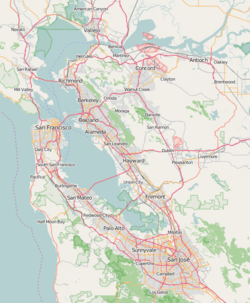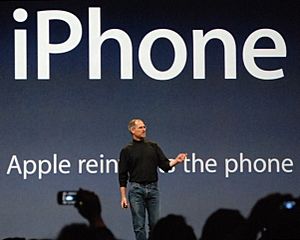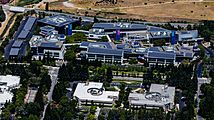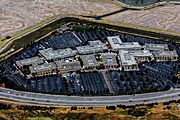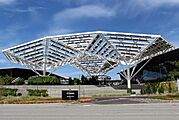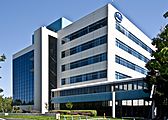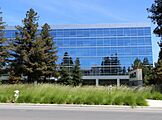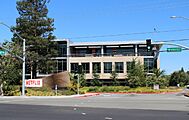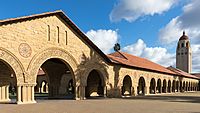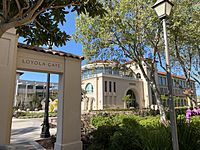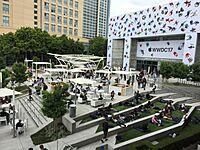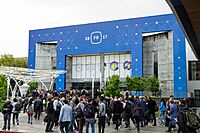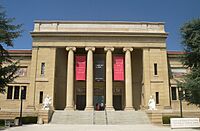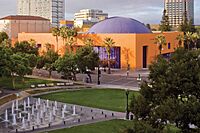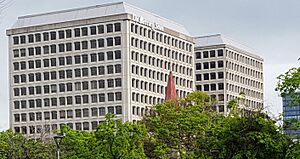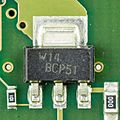Silicon Valley facts for kids
Quick facts for kids
Silicon Valley
|
|
|---|---|
|
|
|
| Country | United States |
| State | California |
| Region | San Francisco Bay Area |
| Megaregion | Northern California |
| Time zone | UTC−8 (Pacific) |
| • Summer (DST) | UTC−7 (PDT) |
Silicon Valley is a famous area in Northern California. It's known as a worldwide hub for high technology and new ideas. This region is in the southern part of the San Francisco Bay Area. It mostly covers the Santa Clara Valley. When people say "Silicon Valley," they mean the place where many high-tech businesses have grown in California. It also stands for California's entire high-tech industry.
Cities like Sunnyvale, Mountain View, Palo Alto, and Menlo Park are often called the birthplace of Silicon Valley. San Jose is the biggest city in Silicon Valley. It's also the third-largest city in California. The San Jose area has one of the highest economic outputs per person in the world. Many homes here are worth over $1 million.
Silicon Valley is home to many of the world's biggest tech companies. It includes the main offices of over 30 businesses from the Fortune 1000 list. Thousands of new companies also start here. About one-third of all venture capital (money invested in new businesses) in the U.S. goes to Silicon Valley. This has made it a top place for tech innovation. Important inventions like the integrated circuit (computer chip), the microprocessor, and the microcomputer were created here. As of 2021, about half a million people worked in information technology in this region.
As more tech companies grew in San Jose and the Santa Clara Valley, the name "Silicon Valley" got two meanings. It can mean the specific area of Santa Clara County and parts of San Mateo County. It can also refer to all high-tech businesses in the wider Bay Area. The name has become a global symbol for leading tech research and companies. It has inspired many other places around the world to call themselves "Silicon" something. Many tech company headquarters in Silicon Valley are now popular places for tourism.
Contents
What's in the Name?
The name "Silicon" comes from the chemical element silicon. This element is used to make silicon-based transistors and integrated circuit chips. These chips are key to computers. Many computer hardware and software companies in the area focus on these silicon parts.
A journalist named Don Hoefler is often given credit for making the name popular. He used the term in his article "Silicon Valley U.S.A." in Electronic News on January 11, 1971. He heard marketing people use the term during a lunch meeting. The term became widely used in the early 1980s. This was when the IBM PC and many related products became popular.
Before the tech industry grew, this region was famous for growing and packing fruit. Up until the 1960s, it was the world's largest fruit-producing area. It was known as "the Valley of Heart’s Delight."
How Silicon Valley Started
Silicon Valley grew because of several things coming together. It had strong science research from local universities. There was also plenty of venture capital (money for new businesses). Government rules were flexible, and the U.S. Department of Defense spent a lot of money on new tech. Stanford University was especially important in the early days. All these things helped the area grow and succeed.
The U.S. had lower taxes on capital gains (money made from investments). This made it easier to invest in businesses. Also, there were fewer rules on new businesses compared to other countries. In 1953, the Small Business Administration was created to help new companies get started. This gave a boost to people with new ideas. Northern California was even more welcoming. Many venture capitalists looked for high-tech business ideas. They gathered on Sand Hill Road in Menlo Park and Palo Alto. California's laws also let workers freely use knowledge from old jobs. This helped Silicon Valley grow faster than other tech areas.
Early Military Connections
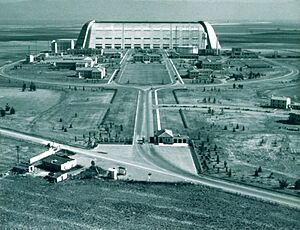
The San Francisco Bay Area has always been important for U.S. Navy research. In 1909, Charles Herrold started the first regular radio station in the U.S. in San Jose. Later, Cyril Elwell bought patents for radio technology. He started the Federal Telegraph Corporation (FTC) in Palo Alto. The FTC built the world's first global radio system. They signed a contract with the Navy in 1912.
In 1933, Air Base Sunnyvale was built for the Navy. It housed the airship USS Macon. Many tech companies set up near Moffett Field to work with the Navy. When the Navy moved most of its operations, National Advisory Committee for Aeronautics (NACA, now NASA) took over parts of Moffett Field. Many original companies stayed, and new ones moved in. The area soon had many aerospace firms. Lockheed was the biggest employer from the 1950s to the 1980s.
Stanford University's Role

Stanford University and its graduates played a big part in creating a culture of teamwork among tech companies. People in California felt a strong sense of local pride. This was different from the competitive feeling among engineering firms on the East Coast of the United States. Since the 1890s, Stanford's leaders wanted to serve the American West. They shaped the school to help local industries grow. This helped Stanford and local tech firms work together.
Frederick Terman, the dean of engineering at Stanford from 1946, told teachers and students to start their own companies. In 1951, Terman helped create Stanford Industrial Park (now Stanford Research Park). Here, the university rented land to high-tech companies. Terman supported companies like Hewlett-Packard, Varian Associates, and Lockheed Corporation. Silicon Valley grew up around the Stanford University campus because of this.
In 1951, to help Stanford grow and offer jobs to students, Terman suggested renting university land for an office park. He only invited high-tech companies. The first company was Varian Associates, started by Stanford alumni. Terman also found venture capital for new tech companies. Hewlett-Packard became a huge success story. Founded in 1939 in Packard's garage by Stanford graduates Bill Hewlett and David Packard, Hewlett-Packard moved to Stanford Research Park in 1953. In 1954, Stanford started a program for company employees to get degrees part-time. Hewlett-Packard became the world's largest personal computer maker. It changed home printing with its first ink-jet printer in 1984.
The Rise of Silicon Chips
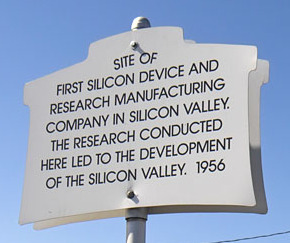
In 1956, William Shockley moved to Mountain View, California. He was a co-inventor of the first working transistor. He started Shockley Semiconductor Laboratory. Shockley believed silicon was better than germanium for making transistors. His ideas led to many electronic inventions for decades. Both Frederick Terman and William Shockley are sometimes called "the father of Silicon Valley."
In 1957, Shockley stopped working on the silicon transistor. Because of his difficult management style, eight engineers left his company. They formed Fairchild Semiconductor. Shockley called them the "traitorous eight." Two of these engineers, Robert Noyce and Gordon Moore, later started Intel.
After Robert Noyce invented the integrated circuit (IC) chip in 1959, the first commercial MOS IC came out in 1964. The first single-chip microprocessor was the Intel 4004. It was designed by Federico Faggin and others at Intel in 1971. In 1974, Intel released the Intel 8080, another important microprocessor.
How the Internet Began Here
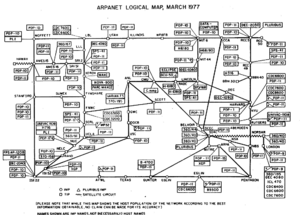
In 1963, J. C. R. Licklider from the Pentagon's ARPA shared his idea for a computer network. He imagined it as an "Intergalactic Computer Network" open to everyone. This network would be the main way for governments, companies, and people to share information. From 1962 to 1964, Licklider started three key things in information technology. These were computer science departments at universities, time-sharing computers, and computer networking. In 1969, the Stanford Research Institute (now SRI International) was one of the first four locations to connect to ARPANET. This was the network that came before the Internet.
Venture Capital Grows
By the early 1970s, Silicon Valley had many semiconductor companies. There were also computer firms and software companies. Space for businesses was easy to find, and housing was still cheap. Growth during this time was boosted by the rise of venture capital firms on Sand Hill Road. Companies like Kleiner Perkins and Sequoia Capital started in 1972. The amount of venture capital grew hugely after Apple Computer's successful stock offering in 1980. Since the 1980s, Silicon Valley has had the most venture capital firms in the world.
In 1971, Don Hoefler looked into where Silicon Valley companies came from. He found that many were linked to investments from the eight co-founders of Fairchild Semiconductor. The main investors in Kleiner Perkins and Sequoia Capital came from this same group. This shows how connected the early tech companies were.
The Role of Lawyers
Before 1970, most lawyers in Northern California were in San Francisco. This included patent attorneys needed by the tech industry. In the 1970s, lawyers started moving to Silicon Valley. They followed the venture capitalists to serve the growing tech industry. By 1999, Palo Alto, a city of only 50,000 people, had 2,400 lawyers. This was one of the highest concentrations of lawyers in the U.S. outside of Washington, D.C.
By 2000, big law firms from all over the world opened offices in Silicon Valley. Lawyers here became very important. They changed from just protecting ideas to being business advisors and dealmakers. For young entrepreneurs, their lawyer often became their first coach and friend. As of 2023, the San Jose-Sunnyvale-Santa Clara area had the highest average lawyer salary in the U.S.
Computer Culture Emerges
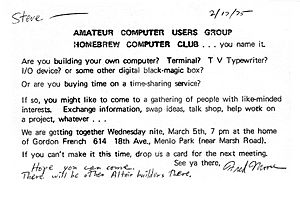
The Homebrew Computer Club was a casual group for people who loved electronics and computers. They met to share parts, ideas, and information about building computers. Gordon French and Fred Moore started it. They wanted a regular place for people to meet and make computers more available to everyone.
The first meeting was in March 1975 at French's garage in Menlo Park. This was when the MITS Altair microcomputer arrived in the area. Steve Wozniak and Steve Jobs said this meeting inspired them to design the first Apple I and Apple II computers. The Apple I was first shown at the Homebrew Computer Club. Later meetings were held at the Stanford Linear Accelerator Center.
The Rise of Software
While computer chips are still important, Silicon Valley is now famous for new ideas in software and Internet services. Silicon Valley has greatly influenced computer operating systems, software, and how people use computers. With money from NASA, the U.S. Air Force, and ARPA, Douglas Engelbart invented the mouse and tools for working together using hypertext. He did this in the 1960s and 1970s at Stanford Research Institute (now SRI International). He first showed them publicly in 1968 in what's called The Mother of All Demos.
Engelbart's team at SRI also helped launch the ARPANET (the Internet's early version). Xerox hired some of Engelbart's best researchers. In the 1970s and 1980s, Xerox's Palo Alto Research Center (PARC) was key to object-oriented programming, graphical user interfaces (GUIs), Ethernet, and laser printers.
Many of Xerox's inventions were used by other companies. This led to companies like 3Com and Adobe Systems. It also indirectly led to Cisco, Apple Computer, and Microsoft. Apple's Macintosh GUI was largely inspired by Steve Jobs' visit to PARC. Cisco's start came from needing to connect different computer networks at Stanford University.
The Internet Age
Commercial use of the Internet slowly became common in the early 1990s. In 1995, Internet use grew a lot. Early internet companies like Amazon.com, eBay, and Craigslist started. Silicon Valley was the center of the dot-com bubble. This was a time when internet company stocks rose very high, then crashed in April 2000. During this time, real estate prices became extremely high. For a short period, Sand Hill Road had the most expensive commercial real estate in the world. The booming economy also caused bad traffic congestion.
After the dot-com crash, Silicon Valley kept its place as a top research and development center. A 2006 The Wall Street Journal story found that 12 of the 20 most inventive towns in America were in California. Ten of those were in Silicon Valley. San Jose led the list with many patents filed. Silicon Valley is also home to many "Unicorn" companies. These are new companies valued at over $1 billion.
Economy and Jobs
The San Francisco Bay Area is a world-famous technology hub. It has the most high-tech companies in the United States. Silicon Valley alone has over 225,300 high-tech jobs. It has the highest number of high-tech workers per person of any major area. Silicon Valley also has the highest average high-tech salary in the U.S., at $144,800. Because of the tech sector, the San Jose-Sunnyvale-Santa Clara area has the most millionaires and billionaires per person in the United States.
This region is the biggest high-tech manufacturing center in the U.S. The unemployment rate here is very low. Silicon Valley received a large share of all U.S. venture investment. Many car manufacturers have also opened offices here. They want to use the area's new ideas. Making transistors was a main industry for a long time. Many workers in this industry were immigrants. They were paid low wages and worked with dangerous chemicals. However, technical, engineering, design, and office staff were usually paid very well.
Housing Challenges
Silicon Valley has a big housing shortage. Many more jobs have been created than homes built. This shortage has made home prices extremely high. They are often too expensive for many workers. In 2016, a two-bedroom apartment rented for about $2,500. The average home price was about $1 million. Some people cannot afford to live here, even those with middle incomes. This causes some residents to move away.
Famous Companies Here
Thousands of high technology companies have their main offices in Silicon Valley. Here are some of the well-known ones:
- Adobe Inc.
- AMD
- Agilent Technologies
- Alphabet Inc., includes Google
- Apple Inc.
- Applied Materials
- Block, Inc.
- Broadcom Inc.
- Cadence Design Systems
- Cisco Systems
- eBay
- Electronic Arts
- HP Inc.
- Intel
- Intuit
- Intuitive Surgical
- Juniper Networks
- KLA Corporation
- Lam Research
- Meta Platforms, includes Facebook
- NetApp
- Netflix, Inc.
- Nvidia
- PayPal
- Salesforce
- Sanmina Corporation
- Seagate Technology
- ServiceNow
- TD Synnex
- Synopsys
- Western Digital
Many other important companies have been based in Silicon Valley. Some have been bought by other companies, or moved their offices.
- 23andMe
- 3Com (acquired by Hewlett-Packard)
- Atari
- Amazon's A9.com
- Amazon's Lab126.com
- Atmel (acquired by Microchip Technology)
- BEA Systems (acquired by Oracle Corporation)
- Cypress Semiconductor (acquired by Infineon Technologies)
- Extreme Networks
- Fairchild Semiconductor (acquired by onsemi)
- Flex (formally Flextronics)
- GoPro
- Hewlett Packard Enterprise (moved to Spring, Texas)
- IDEO
- Informatica
- LinkedIn (acquired by Microsoft)
- Lockheed Martin Space (now headquartered in Denver, Colorado)
- Maxtor (acquired by Seagate)
- McAfee (acquired by Intel)
- Mozilla Foundation
- Oracle Corporation (moved to Austin, Texas)
- Palo Alto Networks
- PARC
- Proofpoint
- Quantcast
- Quora
- Rambus
- Roku, Inc.
- RSA Security (acquired by EMC)
- SanDisk (acquired by Western Digital)
- SolarCity (acquired by Tesla, Inc.)
- Sony Mobile Communications (U.S. subsidiary headquarters)
- Sony Interactive Entertainment
- SRI International
- Sun Microsystems (acquired by Oracle Corporation)
- SunPower
- SurveyMonkey
- Symantec (now part of Gen Digital and headquartered in Tempe, Arizona)
- Tesla, Inc. (now headquartered in Austin, Texas)
- TIBCO Software
- TiVo (acquired by Xperi)
- Uber
- Verifone (moved to Coral Springs, Florida)
- VeriSign (moved to Reston, Virginia)
- Veritas Technologies (split off from Symantec)
- VMware (acquired by Dell Technologies)
- Walmart Labs
- WebEx (acquired by Cisco Systems)
- YouTube (acquired by Google)
- Yelp, Inc.
- Zoom
- Zynga
- Xilinx (acquired by AMD)
People of Silicon Valley
Silicon Valley had a population of 3.1 million people in 2020. A study in 1999 found that one-third of scientists and engineers in Silicon Valley were immigrants. Also, almost a quarter of high-tech companies started since 1980 were led by CEOs of Chinese or Indian descent. Successful immigrant business owners often used their ethnic connections to help them succeed. Many tech employees and managers earn very high salaries. This allows them to have a middle-class lifestyle in Silicon Valley.
Gender Diversity
In 2006, a report found that only 8.8% of Silicon Valley companies had women CEOs. This was the lowest percentage in California. Most leadership roles in Silicon Valley tech are held by men. This is also true for new companies started by women and women-led startups getting funding. Some believe this is due to a lack of encouragement for girls to study science and engineering. Also, most famous tech leaders like Bill Gates and Steve Jobs are men.
As of 2014, some big Silicon Valley firms were actively trying to hire more women. Companies like Apple, Facebook, Google, and Microsoft attended conferences to find female engineers. In 2015, experienced women started their own investment firms. They wanted to use women's viewpoints to fund new companies.
A 2015 article in Newsweek talked about sexism in Silicon Valley. It highlighted stories of unfair treatment towards women. In 2015, a lawsuit called Pao v. Kleiner Perkins brought a lot of attention to gender discrimination. Even though the jury sided with the company, the case made many people more aware of these issues in tech and investment firms.
Racial Diversity
A 2017 study showed that white men held most of the higher positions. They made up 58.7% of executive roles and 46.5% of managers. Asian men were the next largest group. Black and Hispanic/Latino people had the lowest percentages in all job categories.
A 2018 article in Harvard Business Review discussed diversity and inclusion. It shared stories from Black employees in tech. One Black man, LeRon L. Barton, said he rarely saw people who looked like him. He felt isolated and had to constantly prove his skills.
Some successful Black people in Silicon Valley include Roy Clay, who founded Hewlett Packard's computing division. Ken Coleman was an executive at Activision. John W. Thompson was the first Black CEO of a major tech company, Symantec, and later chairman of Microsoft. Robert F. Smith founded a software investment firm. Charles Phillips was president of Oracle. Stacy Brown-Philpot was the first Black female tech CEO at TaskRabbit.
In late 2023 and early 2024, many tech companies faced economic challenges. They had to cut costs and lay off workers. During this time, programs for diversity, equity, and inclusion (DEI) were often reduced or removed first.
More Statistics
In 2014, tech companies like Google, Yahoo!, Facebook, and Apple shared details about their employees. Google said 17% of its tech employees worldwide were women. In the U.S., 1% of its tech workers were Black and 2% were Hispanic. Yahoo! reported 15% women in tech jobs, 2% Black, and 4% Hispanic. Facebook said 15% of its tech workforce was female, 3% Hispanic, and 1% Black.
In August 2014, Apple reported that 80% of its global tech staff was male. In the U.S., 54% of its tech jobs were held by Caucasians and 23% by Asians. USA Today wrote that Silicon Valley's tech industry lacked diversity. It noted that the workforce was mostly white or Asian, and male. Civil rights activist Jesse Jackson called improving diversity "the next step in the civil rights movement."
A 2019 survey found that 48% of high-tech workers in Silicon Valley identify as Christians. Roman Catholicism was the largest branch (27%), followed by Protestantism (19%). The study also found that 16% of tech workers had no specific religion. About 4% identified as Jews or Buddhists, 3% as Hindus, and 2% as Muslims.
Cities in Silicon Valley
The following cities in Santa Clara County are usually considered part of Silicon Valley:
The exact borders of Silicon Valley have changed over time. It used to mean just Santa Clara Valley. Then it included Santa Clara County and nearby areas in San Mateo and Alameda Counties. Now, it sometimes includes San Francisco County and other northern areas. This is because the local economy and new technologies have grown.
Learning and Education
Colleges and Universities
Silicon Valley has many colleges and universities. The most famous are Stanford University, a private school in the Valley, and the University of California, Berkeley, a public school north of Silicon Valley. Both are considered world-leading schools. Other colleges and universities in the area include:
- California University of Management and Technology
- Carnegie Mellon Silicon Valley
- Cañada College
- Chabot College
- De Anza College
- Evergreen Valley College
- Foothill College
- Gavilan College
- Golden Gate University
- International Technological University
- Menlo College
- Mission College
- National University San Jose Campus
- Northwestern Polytechnic University
- Ohlone College
- Palo Alto University
- Palmer College of Chiropractic, West Campus
- Peralta Colleges
- San Jose City College
- San José State University
- Santa Clara University
- Sofia University
- Stanford University
- University of California, Berkeley
- University of California, Santa Cruz, Silicon Valley Campus
- University of San Francisco South Bay Campus
- University of Silicon Valley
- West Valley College
- William Jessup University
High Schools
Public schools in wealthy Silicon Valley towns like Woodside often get extra money from private groups. These groups are funded by local residents. Schools in less wealthy areas like East Palo Alto rely more on state funding.
Culture and Fun
Events to Check Out
- Apple Worldwide Developers Conference, San Jose
- Facebook F8, San Jose
- Silicon Valley Comic Con, San Jose
- Silicon Valley Pride, San Jose
Cool Museums
- Computer History Museum
- Children's Discovery Museum of San Jose
- De Saisset Museum at Santa Clara University
- Hiller Aviation Museum
- History Park by History San José
- The HP Garage
- Intel Museum
- Los Altos History Museum
- Moffett Field Historical Society Museum
- Palo Alto Art Center
- Sunnyvale Heritage Park Museum
- The Tech Museum of Innovation
News and Media
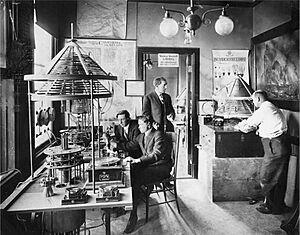
In 1980, Intelligent Machines Journal became InfoWorld. With offices in Palo Alto, it started covering the growing microcomputer industry.
Local and national news outlets cover Silicon Valley. CNN, The Wall Street Journal, and Bloomberg News have offices in Palo Alto. Public broadcasters KQED and KGO-TV have offices in San Jose. KNTV, the local NBC station, is also in San Jose. They produce the national TV show "Tech Now." San Jose-based media include the daily San Jose Mercury News and the weekly Metro Silicon Valley.
Specialty media include El Observador and the San Jose / Silicon Valley Business Journal. Most other major TV stations and newspapers are in San Francisco or Oakland. Patch.com has websites that provide local news and events for Silicon Valley residents. Mountain View has a public TV station, KMVT-15.
Images for kids
-
Silicon Valley gets its name from the silicon used in transistors and computer chips.
See also
 In Spanish: Silicon Valley para niños
In Spanish: Silicon Valley para niños







